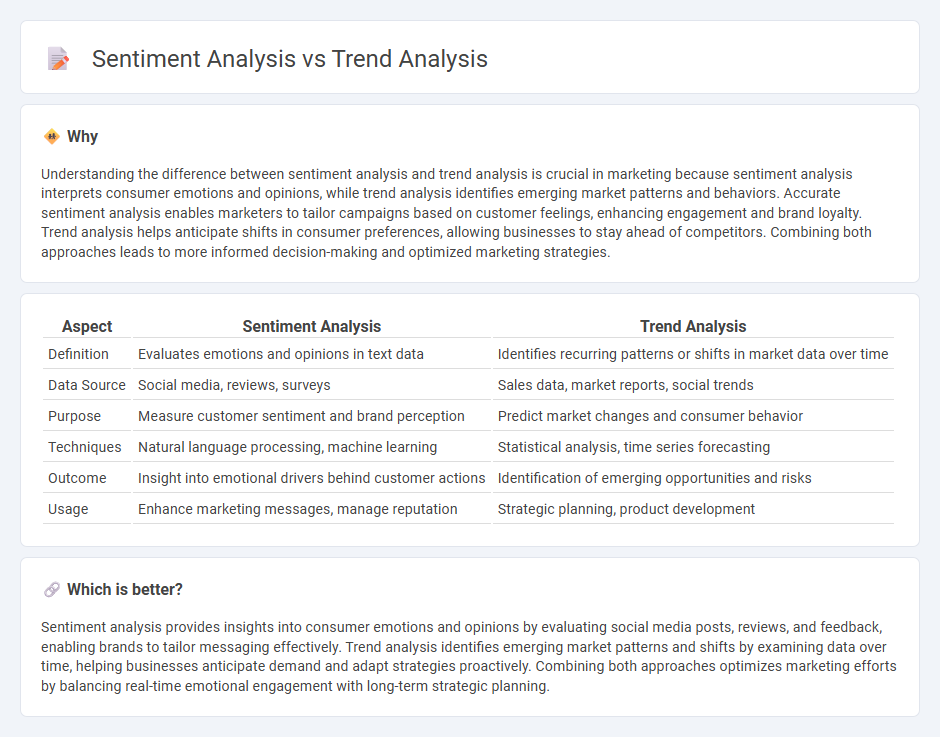
Sentiment analysis focuses on understanding consumer emotions and opinions by analyzing textual data across social media, reviews, and surveys to gauge brand perception and customer satisfaction. Trend analysis examines patterns and shifts in market behavior and consumer preferences over time, helping businesses anticipate emerging opportunities and threats. Explore how combining these powerful techniques can optimize your marketing strategy and drive growth.
Why it is important
Understanding the difference between sentiment analysis and trend analysis is crucial in marketing because sentiment analysis interprets consumer emotions and opinions, while trend analysis identifies emerging market patterns and behaviors. Accurate sentiment analysis enables marketers to tailor campaigns based on customer feelings, enhancing engagement and brand loyalty. Trend analysis helps anticipate shifts in consumer preferences, allowing businesses to stay ahead of competitors. Combining both approaches leads to more informed decision-making and optimized marketing strategies.
Comparison Table
| Aspect | Sentiment Analysis | Trend Analysis |
|---|---|---|
| Definition | Evaluates emotions and opinions in text data | Identifies recurring patterns or shifts in market data over time |
| Data Source | Social media, reviews, surveys | Sales data, market reports, social trends |
| Purpose | Measure customer sentiment and brand perception | Predict market changes and consumer behavior |
| Techniques | Natural language processing, machine learning | Statistical analysis, time series forecasting |
| Outcome | Insight into emotional drivers behind customer actions | Identification of emerging opportunities and risks |
| Usage | Enhance marketing messages, manage reputation | Strategic planning, product development |
Which is better?
Sentiment analysis provides insights into consumer emotions and opinions by evaluating social media posts, reviews, and feedback, enabling brands to tailor messaging effectively. Trend analysis identifies emerging market patterns and shifts by examining data over time, helping businesses anticipate demand and adapt strategies proactively. Combining both approaches optimizes marketing efforts by balancing real-time emotional engagement with long-term strategic planning.
Connection
Sentiment analysis provides real-time insights into consumer emotions by evaluating social media posts, reviews, and feedback, helping marketers understand public perception. Trend analysis identifies emerging patterns in consumer behavior and market dynamics, allowing brands to anticipate shifts and adapt strategies. Combining sentiment analysis with trend analysis enables marketers to align campaigns with evolving consumer attitudes and optimize product positioning for maximum engagement.
Key Terms
**Trend Analysis:**
Trend analysis identifies patterns and shifts in data over time, enabling businesses to predict future movements and make informed decisions. It leverages historical sales figures, market behavior, and consumer preferences to uncover emerging opportunities and potential risks. Explore how trend analysis can enhance your strategic planning and competitive edge.
Time Series
Trend analysis leverages time series data to identify patterns, shifts, and long-term movements within a dataset, often used in financial markets, sales forecasting, and economic studies. Sentiment analysis interprets textual data to gauge public opinion, emotions, or attitudes over time, providing real-time insights into consumer behavior and market reactions. Explore how integrating both time series trend and sentiment analysis can enhance predictive accuracy and strategic decision-making.
Pattern Recognition
Trend analysis identifies long-term shifts in data by detecting recurring patterns and trajectories across time series, market behavior, or consumer activities. Sentiment analysis interprets textual data to gauge emotional tones, opinions, and attitudes, uncovering public perception trends in social media, reviews, and feedback. Explore further to understand how pattern recognition bridges these analytical approaches and drives actionable insights.
Source and External Links
Trend Analysis: Definitions, Types of Trends and FAQs | Indeed.com - Trend analysis is a technique that uses financial statements to identify market patterns and forecast future performance by plotting data on graphs to recognize uptrends, downtrends, and horizontal trends for informed business decisions.
What is Trend Analysis? Definition, Examples and Methods - Trend analysis involves comparing historical data points over time through descriptive, comparative, predictive, or technical methods to identify meaningful patterns and apply these insights to business strategies.
What Is Trend Analysis? Types & Best Practices - NetSuite - Trend analysis is a statistical method that examines historical data patterns such as time-series and regression analysis to predict future business dynamics and enable companies to adjust strategies like inventory and marketing accordingly.
 dowidth.com
dowidth.com